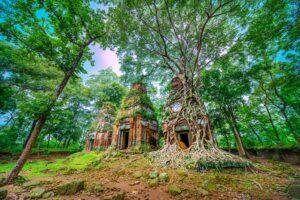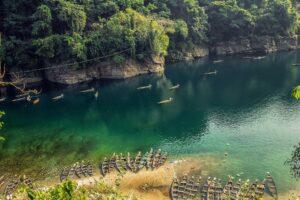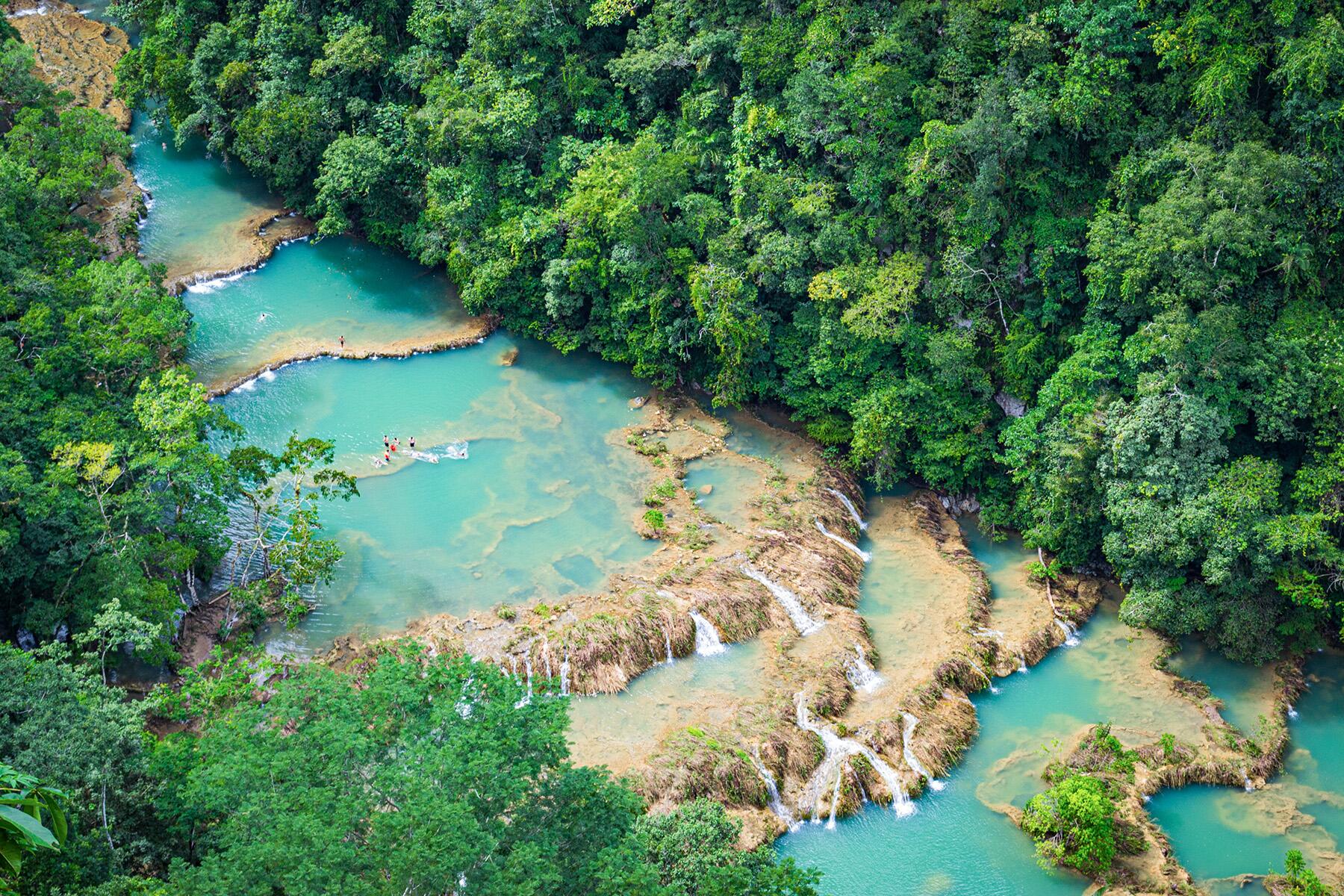
Asia
Top places to go in Asia in 2025
Expand Full List



-
Koh Ker, Cambodia
![]()
-
Meghalaya, India
![]()
-
Nikko, Japan
![]()



Koh Ker
Cambodia
Keen to avoid the selfie stick-wielding tourists flocking to Angkor Wat and its surrounding temples? Consider Koh Ker, a sprawling archaeological site that provides a fascinating insight into lesser-known aspects of the Khmer empire.
This spectacular temple complex granted UNESCO World Heritage status in late 2023, has Asia’s only seven-tiered temple. It was the capital of Cambodia’s Khmer Empire between 928 and 944 C.E. and comprises 80 temples, many of which are on the verge of being reclaimed by the surrounding jungle; structures such as Prasat Pram have tendril-like banyan tree roots wrapped so tightly around them that they would be significantly less stable were they ever removed.
The temples were built as an alternative to Angkor Wat by King Jayavarman IV after a presumed breakdown in the line of succession, and its remote location—it’s a three-hour drive from Siem Reap—has been both a blessing and a curse. There are (for now) fewer tourists, although its isolation is also the reason it was heavily plundered in the late 1900s.
Much of this looting—of which empty plinths and piles of broken bricks serve as reminders—was carried out by British art dealer Douglas Latchford, and in recent years, a growing number of museums have returned the ill-gotten gains he supplied. Thankfully, with its recent UNESCO designation, there’s a sense the site is now in safer hands, although we recommend visiting sooner rather than later before those selfie stick-wielding masses arrive.
The Jaya House River Park Hotel, in the center of Siem Reap, is one of Cambodia’s most sustainable hotels—it’s plastic-free, supports several local charities, and provides every guest with a flask from Refill Not Landfill, founded to reduce plastic waste. For another option, stay at the Royal Crown Hotel and Spa and you’ll be just across the river from the historic French Quarter. Doubles start from just $32 a night, room only.
The best time to visit Koh Ker is between December and February, when it’s dry and sunny. Expect temperatures of between 77 degrees Fahrenheit and 86 degrees Fahrenheit.
Insider Tip
Wear decent hiking boots. Infrastructure improvements are being carried out to make Koh Ker’s temples safer and easier to access, but for now, boots with decent ankle support will minimize the risk of sprained ankles courtesy of untamed tree roots and crumbling footpaths.



Meghalaya
India
Located in the northeastern corner of India, Meghalaya (meaning “abode of the clouds”) is a mountainous state where the natural world puts its best foot forward. It’s home to breathtaking waterfalls with the most dramatic cascades found in Cherrapunji and Mawsynram—two of the wettest places on Earth.
In Meghalaya, you’ll find 1,700 limestone and sandstone caves for spelunking, emerald-hued natural pools for wild swimming, and rivers to paddle. Hike centuries-old living bridges sculpted from tree roots, like the stupendous double-decker bridge at Nongriat, which involves a strenuous 3,500-step trek. And for those keen on more leisurely pursuits, there’s the riverside beach in Shnongpdeng village, where you can explore. No wonder Meghalaya is also a paradigm of green living, exemplified by Mawlynnong, a no-smoking, no-plastic, and no-litter village.
For a dose of culture, visit the state capital of Shillong. Watch rock bands at Dylan’s Cafe (named after Bob Dylan), wander flower-filled gardens around Ward’s Lake, learn about the region’s tribal groups at Don Bosco Museum, and try the indigenous food with a modern twist at Police Bazar, the city’s main market.
For an upscale experience, reserve a room at the 101-key Vivanta Meghalaya, the state’s first five-star hotel, or bed down at the former royal summer palace-turned-hotel, The Heritage Club, Tripura Castle. For a more affordable stay, check into Cafe Shillong Bed and Breakfast, which offers clean, modern rooms while retaining the nostalgic charm of its historic setting.
October to February is a great time to explore Meghalaya as the weather is cool with mostly clear skies, and the state’s waterfalls and rivers have been replenished by monsoon rains. Furthermore, this season also brings a lively array of festivals and events, such as the Wangala Harvest Festival, the Hills Festival, and the Shillong Cherry Blossom Festival.
Insider Tip
Hire a driver from the Police Bazar taxi stand in Shillong to shuttle you to waterfalls and other natural attractions for around $80 to $95 per day, depending on the car and your itinerary.



Nikko
Japan
There’s a Japanese saying that goes, “Never say kekko (which means you’re satisfied) until you’ve seen Nikko.” The adage makes sense once you glimpse the little city’s sweeping landscapes: think forest trails that open at waterfalls and steaming hot springs under dramatic mountain ranges. Located north of Tokyo, Nikko has long been a favorite retreat spot for capital-dwellers. A getaway is now easier than ever with Spacia X, a luxurious train that debuted in 2023 and whisks travelers from Asakusa to Tobu Nikko station in under two hours.
Wander the easy paths around Lake Chūzenji, or hike the three-hour-long Senjōgahara trail through marshlands framed by volcanic Mount Nantai. Look up at Kegon Falls, a narrow, 97-meter (318-foot) tall chute that crashes into the deep blue lake. Nikko also has a rich spiritual culture that reached its zenith with Tōshogū, an opulent Shinto and Buddhist complex. The colorful shrine was carved in 1617 and honors Tokugawa Ieyasu, founder of the Tokugawa shogunate that ruled Japan for over 250 years.
Be on the lookout for dishes with yuba or tofu skin: this local specialty is typically served over rice or soba or eaten fresh sashimi-style. After dinner, take a soak under the stars in one of the famous onsen or geothermal baths. As Tokyo and Kyoto grow more crowded with tourists each year, a stay in Nikko is just the ticket for a peaceful journey in Japan.
Nikko Kanaya Hotel is Japan’s oldest Western-style resort and has welcomed guests such as Helen Keller, Albert Einstein, and U.S. President Dwight Eisenhower. Hotel Tokugawa is a luxurious Japanese-style inn located near Tōshōgū Shrine that offers suites with private onsen baths, as well as shared indoor and open-air hot springs.
While Nikko is a stunning destination year-round, the scenery is particularly delightful in late autumn when the weather cools, and the leaves turn into fiery shades of red and orange.
Insider Tip
The Spacia X limited express train to Nikko books out quickly. Be sure to reserve tickets in advance, especially if you are traveling on weekends and during peak seasons.



























